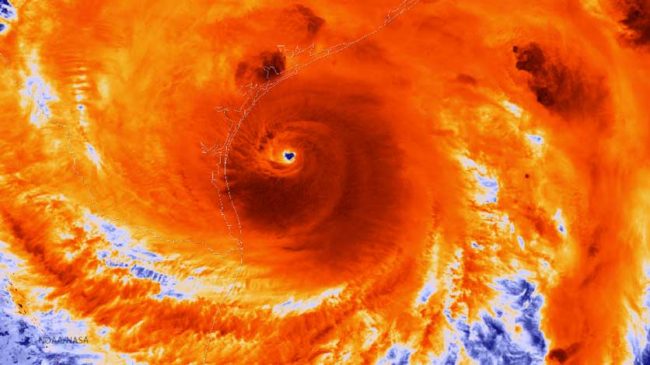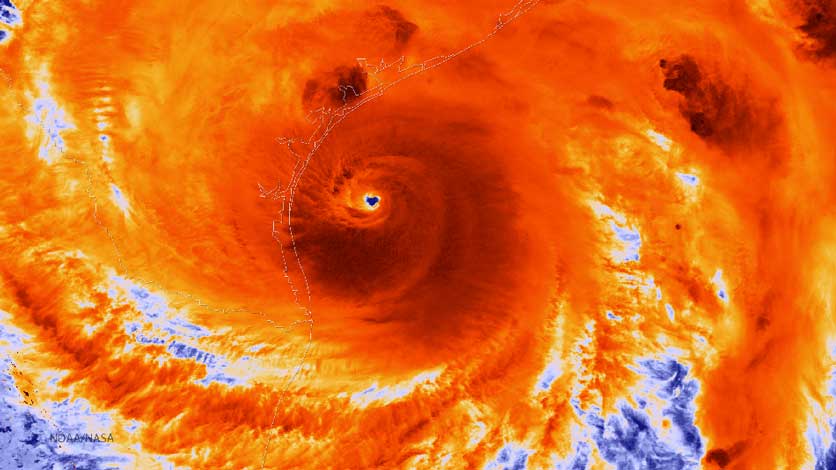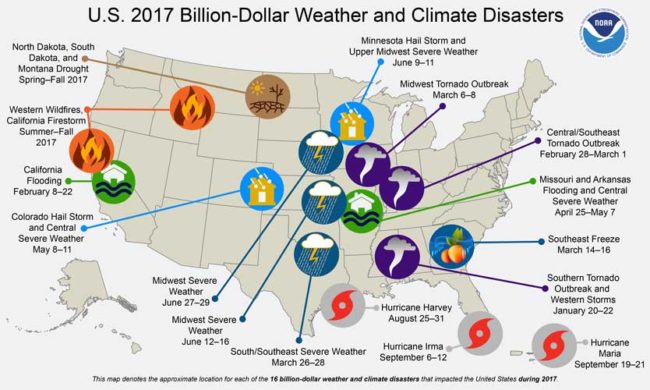
Addressing Climate Change is often perceived to be a costly effort and so some might argue that doing nothing is a viable option. The problem with that thought is that the cost of doing nothing is going to increase year by year. NOAA has now completed calculating the numbers for 2017 and the costs adds up to a whopping $306 billions worth of Climate Disasters.
Can we really attribute such events to Climate Change?
There is scientific evidence that such extreme events are now made a lot worse because of climate change. While natural variability does lay a foundation for such events, human caused climate change allowed them to pass a threshold that they could not otherwise have exceeded.
Climate change is also paying an increasing role in the increasing frequency of some types of extreme weather that lead to billion-dollar disasters. Most notably the rise in vulnerability to drought, lengthening wildfire seasons and the potential for extremely heavy rainfall and inland flooding events are most acutely related to the influence of climate change (NCA 2014).
NOAA: Billion-Dollar Weather and Climate Disasters: Overview
The U.S. National Oceanic and Atmospheric Administration (NOAA) released the final statistics for billion dollar weather events in 2017 a few days ago and so we now have a picture of the associated costs.
They explain exactly how such costs are calculated …
In performing these disaster cost assessments these statistics were taken from a wide variety of sources and represent, to the best of our ability, the estimated total costs of these events — that is, the costs in terms of dollars that would not have been incurred had the event not taken place. Insured and uninsured losses are included in damage estimates. Sources include the National Weather Service, the Federal Emergency Management Agency, U.S. Department of Agriculture, National Interagency Fire Center, U.S. Army Corps, individual state emergency management agencies, state and regional climate centers, media reports, and insurance industry estimates. Please see Calculating the Cost of Weather and Climate Disasters for more information.
There have been 16 extreme weather related events in the US during 2017 where the cost exceeded $1 billion. The following diagram identifies them.
These events included 1 drought event, 2 flooding events, 1 freeze event, 8 severe storm events, 3 tropical cyclone events, and 1 wildfire event.
The Frequency of such events in increasing
If you look back over the period 1980 to now, then on average there were 5.8 of these billion dollar weather events. During the past five years that frequency has increased to an average of 11.6 events per year. 2017 has 16.
Costs
The cumulative damage of these events is $306.2 billion, which shattered the previous U.S. annual record cost of $214.8 billion (CPI-adjusted) in 2005 due to the impacts of Hurricanes Dennis, Katrina, Rita and Wilma. The damage from Hurricanes Harvey, Irma and Maria alone are responsible for approximately $265.0 billion of the $306.2 billion (NOAA 2017). Each of these destructive hurricanes now joins Katrina and Sandy, in the new top 5 costliest U.S. hurricanes on record.
Event Breakdown
You can pull out a very precise list for each event over the years. Here is 2017 (extracted from here).
|
EVENT
|
BEGIN
DATE |
END
DATE |
SUMMARY
|
CPI-ADJUSTED
ESTIMATED COST (IN BILLIONS) |
DEATHS
|
|---|---|---|---|---|---|
|
Summer-Fall 2017
|
2017-06-01 | 2017-12-31 | A historic firestorm damages or destroys over 15,000 homes, businesses and other structures across California in October. The combined destruction of the Tubbs, Atlas, Nuns and Redwood Valley wildfires represent the most costly wildfire event on record, also causing 44 deaths. Extreme wildfire conditions in early December also burned hundreds of homes in Los Angeles. Numerous other wildfires across many western and northwestern states burn over 9.8 million acres exceeding the 10-year annual average of 6.5 million acres. Montana in particular was affected by wildfires that burned in excess of 1 million acres. These wildfire conditions were enhanced by the preceding drought conditions in several states. | $18.0 CI | 54 |
|
Spring-Fall 2017
|
2017-03-01 | 2017-12-31 | Extreme drought causes extensive impacts to agriculture in North Dakota, South Dakota and Montana. Field crops including wheat were severely damaged and the lack of feed for cattle forced ranchers to sell off livestock. This drought has also contributed to the increased potential for severe wildfires. | $2.5 CI | 0 |
|
September 2017
|
2017-09-19 | 2017-09-21 | Category 4 hurricane made landfall in southeast Puerto Rico after striking the U.S. Virgin Island of St. Croix. Maria’s high winds caused widespread devastation to Puerto Rico’s transportation, agriculture, communication and energy infrastructure. Extreme rainfall up to 37 inches caused widespread flooding and mudslides across the island. The interruption to commerce and standard living conditions will be sustained for a long period, as much of Puerto Rico’s infrastructure is rebuilt. Maria tied Hurricane Wilma (2005) for the most rapid intensification, strengthening from tropical depression to a category 5 storm in 54 hours. Maria’s landfall at Category 4 strength gives the U.S. a record three Category 4+ landfalls this year (Maria, Harvey, and Irma). | $90.0 CI | 65 |
|
September 2017
|
2017-09-06 | 2017-09-12 | Category 4 hurricane made landfall at Cudjoe Key, Florida after devastating the U.S. Virgin Islands – St John and St Thomas – as a category 5 storm. The Florida Keys were heavily impacted, as 25% of buildings were destroyed while 65% were significantly damaged. Severe wind and storm surge damage also occurred along the coasts of Florida and South Carolina. Jacksonville, FL and Charleston, SC received near-historic levels of storm surge causing significant coastal flooding. Irma maintained a maximum sustained wind of 185 mph for 37 hours, the longest in the satellite era. Irma also was a category 5 storm for longer than all other Atlantic hurricanes except Ivan in 2004. | $50.0 CI | 97 |
|
August 2017
|
2017-08-25 | 2017-08-31 | Category 4 hurricane made landfall near Rockport, Texas causing widespread damage. Harvey’s devastation was most pronounced due to the large region of extreme rainfall producing historic flooding across Houston and surrounding areas. More than 30 inches of rainfall fell on 6.9 million people, while 1.25 million experienced over 45 inches and 11,000 had over 50 inches, based on 7-day rainfall totals ending August 31. This historic U.S. rainfall caused massive flooding that displaced over 30,000 people and damaged or destroyed over 200,000 homes and businesses. | $125.0 CI | 89 |
|
June 2017
|
2017-06-27 | 2017-06-29 | Severe hail and high wind damage impacting Nebraska, Illinois and Iowa. More than one dozen tornadoes touched down across parts of Iowa, in addition to other storm damage. | $1.4 CI | 0 |
|
June 2017
|
2017-06-12 | 2017-06-16 | Severe hail, high winds and numerous tornadoes impact many states over several days including WY, TX, NE, KS, MO, IA, IL, PA, VA, NY. | $1.5 CI | 0 |
|
June 2017
|
2017-06-09 | 2017-06-11 | Severe hail and high winds cause considerable damage across Minnesota and Wisconsin. The Minneapolis metro area in particular was damaged from large, destructive hail impacting many buildings and vehicles. This damage is comparable to the May 15, 1998 Minnesota hail storm that was also very costly. | $2.4 CI | 0 |
|
May 2017
|
2017-05-08 | 2017-05-11 | Hail storm and wind damage impacting several states including CO, OK, TX, NM, MO. The most costly impacts were in the Denver metro region where baseball-sized hail caused the most expensive hail storm in Colorado history, with insured losses exceeding 2.2 billion. | $3.4 CI | 0 |
|
May 2017
|
2017-04-25 | 2017-05-07 | A period of heavy rainfall up to 15 inches over a multi-state region in the Midwest caused historic levels of flooding along many rivers. The flooding was most severe in Missouri, Arkansas and southern Illinois where levees were breached and towns were flooded. There was widespread damage to homes, businesses, infrastructure and agriculture. Severe storms also caused additional impacts during the flooding event across a number of central and southern states. | $1.7 CI | 20 |
|
March 2017
|
2017-03-26 | 2017-03-28 | Large hail and high winds in Texas north of the Dallas metro region caused widespread damage to structures and vehicles. Severe storms also caused damage across several other states (OK, TN, KY, MS, AL) due to the combination of high winds, hail and tornadoes. | $2.7 CI | 0 |
|
March 2017
|
2017-03-14 | 2017-03-16 | Severe freeze heavily damaged fruit crops across several southeastern states (SC, GA, NC, TN, AL, MS, FL, KY, VA). Mid-March freezes are not climatologically unusual in the Southeast, however many crops were blooming 3+ weeks early due to unusually warm temperatures during the preceding weeks. Damage was most severe in Georgia and South Carolina. Crops most impacted include peaches, blueberries, strawberries and apples, among others. | $1.0 CI | 0 |
|
March 2017
|
2017-03-06 | 2017-03-08 | Tornado outbreak and wind damage across many Midwestern states (AR, IA, IL, KS, MI, MN, MO, NE, NY, OH, WI). Missouri and Illinois were impacted by numerous tornadoes while Michigan and New York were affected by destructive, straight-line winds following the storm system. Nearly one million customers lost power in Michigan alone due to sustained high winds, which affected several states from Illinois to New York. | $2.2 CI | 2 |
|
March 2017
|
2017-02-28 | 2017-03-01 | Over 70 tornadoes developed during a widespread outbreak across many central and southern states causing significant damage. There was also widespread straight-line wind and hail damage. This was the second largest tornado outbreak to occur early in 2017. | $1.8 CI | 6 |
|
February 2017
|
2017-02-08 | 2017-02-22 | Heavy, persistent rainfall across northern and central California created substantial property and infrastructure damage from flooding, landslides and erosion. Notable impacts include severe damage to the Oroville Dam spillway, which caused a multi-day evacuation of 188,000 residents downstream. Excessive rainfall also caused flood damage in the city of San Jose, as Coyote Creek overflowed its banks and inundated neighborhoods forcing 14,000 residents to evacuate. | $1.5 CI | 5 |
|
January 2017
|
2017-01-20 | 2017-01-22 | High wind damage occurred across southern California near San Diego followed by 79 confirmed tornadoes during an outbreak across many southern states including AL, FL, GA, LA, MS, SC and TX. This was the 3rd most tornadoes to occur in a single outbreak during a winter month (Dec.-Feb.) for records going back to 1950. | $1.1 CI | 24 |
†Please note hyperlinked reports were compiled using preliminary data, and the statistics will not always match the latest figures presented here. Event cost data will be updated as new information becomes available.
The confidence interval (CI) probabilities (75%, 90% and 95%) represent the uncertainty associated with the disaster cost estimates. Monte Carlo simulations were used to produce upper and lower bounds at these confidence levels (Smith and Matthews, 2015).
Bottom Line
When it comes to Climate Change, doing nothing is not an option.

